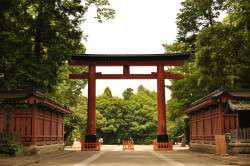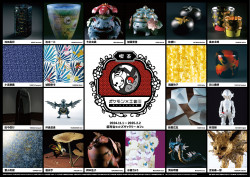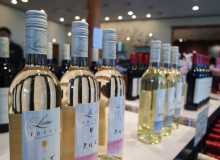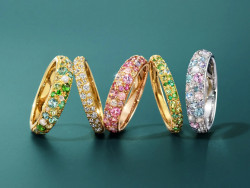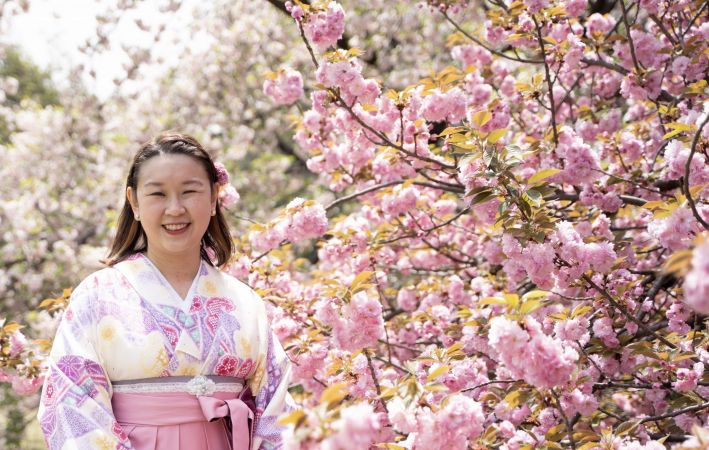
Wanping Aw actually launched her travel agency in the middle of the pandemic. After 13 years of living in Japan, the Project Research Associate at Keio University, who is originally from Singapore, has found a way to give back to Japan and pursue her dream of developing cross-cultural understanding. She is trilingual, has experience as a travel guide and aims to promote sustainable tourism. Aw also aspired to help save Japan’s heritage through her agency, TokudAw, which provides a variety of interactive tours and experiences such as charity rice planting, samurai and ninja experiences and customized private tours designed for immersion into Japanese traditional culture.
To set up this company in Japan, she needed to pass the Domestic Certified Travel Supervisor Exam. The pass rate was only 30%, so she went to a cram school every Sunday for a half year from April 2019. After she earned the license, the pandemic hit. Despite this, she remained focused on her dream and her company TokudAw survived, not through travel but by selling a 100% Japanese Silk Mask, made of Samurai Silk, a registered Japanese cultural heritage item, in combination with SWIFF spray. This product’s anti-viral and anti-bacterial properties are reported in academic journals and papers, but its popularity waned as Japanese fashion and consumerism evolved.
Metropolis spoke to Aw about how science and adaptability played an active role in helping tourism and the tradition of Samurai Silk survive.

Metropolis: Can you tell us about your business?
Wanping Aw: We are mainly a tour agency providing private tours around Japan. The mission of our company is to bridge the distance between Japanese people and people from overseas so that the world can be a better place and become more peaceful. I hope to help the Japanese and people from other countries understand each other better by using the activities of my company and one of the activities is tourism. We also offer other services like translation and consulting services for newcomers to start up their lives and business in Japan. So basically, what we do is to help international visitors have a good time in Japan.
You were already working at Keio University, which is considered a success for most people. Why did you also decide to start your business?
I felt like my work in Keio could not cover everything I wanted to do. When I came to Japan, I received a lot of help from the Japanese government and the Japanese people. I love this country. I found so many peaceful places that I want to share with the world. I also want to clear up the misunderstandings about Japan that Japanese people are stereotypically difficult to work with, and that Japan is an excellent place to travel, but not suitable for staying a long time. I want to build a genuinely good relationship between Japan and overseas, and help to maintain traditional Japanese industries.
I would love to see our customers experience our tours, feel it’s a good idea and build similar businesses in their own countries when they get back.
I started the company with my Japanese business partner. He was a bus driver serving the inbound tourism market. As I liked to travel, I was an assistant bus guide helping to guide tourists who speak English. We cooperated a few times and got positive feedback from the customers, so we thought it would be a good idea to start a tourism company together. We considered it for a long time but didn’t make this decision until we really believed we could make it happen.
We had different reasons for starting the company. He thought that Japan had not improved enough in the last decade or so. He believed that Japan needed to improve, or it would be left behind. He felt that when the local Japanese people can interact with overseas travelers, they will be able to learn something like foreign culture and then try to improve themselves. In short, we wanted to start a company that could help society.
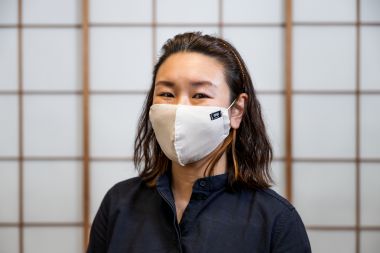
It sounds like a very brave decision to start your business in tourism during the pandemic. Why did you decide to do this?
To start a travel company, we needed to have significant startup capital. The initial plan was to earn enough startup capital in 2019 but the pandemic came in February 2020, and we couldn’t see any end to it. So, we decided why don’t we pick out our savings first, start the company, and then see how far we can go?
What’s sustainable tourism?
Sustainable tourism is to promote tourism in a particular area. You make sure that the area’s tradition and cultural heritage are well preserved, bring more people into that area to work, and create more jobs for the community.
For example, we have a charity rice planting tour. Many farmers now use too much fertilizer and pesticide to grow rice, which will harm us in the long run, since it may increase the possibility of diseases like cancer. We cooperate with an organic rice farmer and her family in Nagano Prefecture, she does organic farming without using fertilizer and pesticides and does everything by hand. That’s a very tough job and they are short of workers, but when we bring people to her farm and help her with the farming, she can maintain her business and teach more people about organic farming.
When more people are aware of the importance of organic farming and become more conscious when choosing rice, it’s more likely that we can preserve original farming methods instead of using farming machinery and pesticides. This is sustainability.
How did you come up with the idea of the Samurai Silk Mask?
If you start a company that mainly does tourism during the pandemic, you will find it very difficult to get any business. I decided to try exporting high-quality Japanese items during the pandemic. I wanted to look for something high quality, something interesting, related to Japanese history, and connected with an area that I want to bring tourists to. Meanwhile, I hoped to make a product that could protect people during the pandemic.
After researching many products, I chose this Samurai Silk because, during the pandemic, everybody needs a mask. I hope that when people buy a product or learn more about the story behind the product, they’ll be interested in knowing more about where it comes from.
Following the Meiji Restoration in 1868, around 3,000 former samurai and approximately 500,000 other workers of the Shonai Clan contributed to the modernization of Japan by cultivating present-day Yamagata Prefecture. In doing so, they developed Japan’s largest silkworm breeding business in the area now known as Tsuruoka, which has since become a National Historic Site of Japan.
This is the only place in Japan where all stages of silk production from the breeding of silkworms, to the collection of silk, weaving, refining and printing take place in the same area. The whole process is totally handmade using techniques that have been passed down over 150 years, making Samurai Silk and its production techniques a Japan Heritage Cultural Property.
We didn’t want to simply sell this product. We want to preserve the industry by letting more people know about Samurai Silk and be interested in its roots. That’s why we specially added the sign of Samurai Silk on the masks and the place of origin inside the masks. We want more people to visit this place and make purchases there. Some luxury brands like Luis Vuitton and Burberry also buy the silk fabric from the company that I purchase the silk from, but the final products of these brands don’t show where the silk comes from.
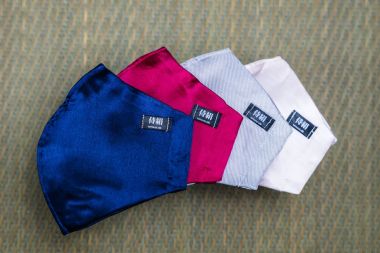
How is your research related to the company?
Many people feel like reusable masks are not sanitary enough and cannot be anti-bacterial. So my research partner, Dr. Joseph J. Richardson from the University of Tokyo, and I cut the silk into small pieces and used it to do experiments, testing the anti-bacterial and anti-viral properties of the Samurai Silk.
Silk is a kind of protein, and my partner was developing a technology related to protein. He wanted to sell his technology, and I wanted to sell the silk, so we decided to cooperate in doing this research to see what was going on. In the paper, you can find that this silk had better anti-bacterial properties than the other reusable materials without using the sanitizing spray. Then we see that with this silk, when used with the SWIFF spray, almost all bacteria can be prevented.

What challenges did you face in building this business?
The biggest challenge for us was finding customers. There were no tourists, we could only have some foreigners who were already in Japan to experience the tours. We even contacted some international schools, telling them we had some activities that were suitable for students, asking them if they had interests. We have many activities that we are hoping younger generations can participate in so that when they become older, they’ll be more open-minded and less biased about different cultures.
To create the tours, I searched online to find something or someone special and called them to ask for cooperation. Sometimes they would be overwhelmed. For example, on the charity rice planting Tour, they were afraid that they couldn’t handle 40 or 50 foreigners at one time because they had limited experience with overseas guests. So, I explained to them that we only provide private tours, which might be only 5-10 people in a group at one time, which they found manageable. By holding the tour, we have donated 50kg of rice to the refugees in Japan through the United Will Association.
What is your future plan after the pandemic?
Selling the masks and protecting Japanese culture and history by connecting them with tangible products and intangible experiences were just ways to get by during the pandemic. After the pandemic, we may bring our customers to the silk factory and let them learn how to color the silk or press the pattern.
Now that foreigners can come to Japan, we will physically bring our customers to the places we’re passionate about, letting them actually experience the local culture. Recently, we have contacted some artisans who maintain traditional techniques from the Edo Period. We are cooperating with an armor artisan, Kato Icchu the Second, one of the ten armor makers in Japan and the only artisan able to create real, genuine armor and helmets, backed by Japanese historical evidence and artifacts. He learned the techniques from his father, Kato Icchu the First, who repaired many of the armor and helmets designated as Japanese national treasures or cultural properties. We hope to bring our customers to him to learn how to make some pretty armor after the pandemic.
Now, as Japan’s border measures are being relaxed and tourists are beginning to return, I hope my customers can not only learn about Japanese culture but also receive happiness and friendship with the suppliers of these activities by joining the journey.
Learn more about TokudAw‘s experiences via their website.
